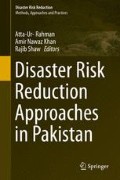Abstract
The significance of promoting disaster risk reduction at international, national and local levels has been recognized in the UN-World Conference on Disaster Reduction (WCDR). Under the Hyogo Framework for Action (HFA) 2005–2015, all nations were agreed in 2005 to prepare National disaster risk reduction plan specifically focusing on five priority areas. In this perspective, the Pakistan National Disaster Management Plan was developed in 2012 as a part of institutionalization process. This plan especially attempts to take care of vulnerable peoples such as women, marginalized people, elderly people and disabled people and also clarify the roles of the national and local governments and residents for each type of disaster. When disaster takes place, it does not discriminate the gender and its impacts vary for male and female. In this connection, the Pakistan national climate change policy 2013 also intensifies the measures to mitigate the damages by disasters and to ensure that the elderly, the disabled, children and women get particular focus in evacuation strategies. The analysis further reveals that there should be disaster management training especially for vulnerable groups of people such as the elderly, disabled, children, and pregnant women and this need to be implemented in close coordination with community. It has been found that in any disaster the worst affected section of the community is the women and children and its impact varies depending on resilience capacity of individuals, households and community and to recover from the impacts of disasters. Higher the vulnerability maximum is the impact of disasters. In addition to women, children and disables, usually hit the hard because of their high vulnerability and low resilience. The chapter also discusses the tools for gender mainstreaming and engendered government policy, women and disaster impacts, gender in recovery phase, causes of women vulnerability, women are at risk and gender and DRR in Pakistan
Access this chapter
Tax calculation will be finalised at checkout
Purchases are for personal use only
References
Cannon T (2000) Vulnerability analysis and disasters. In: Parker DJ (ed) Floods. Rutledge, London
Cannon T (2010) Gender and climate hazards in Bangladesh. Gend Dev 10(2):45–50
Enarson E, Scanlon J (1999) Gender patterns in flood evacuation: a case study in Canada’s red river valley. Appl Behav Sci Rev 7(2):103–124
Fordhan M (2004) Gendering vulnerability analysis: towards more nuanced approach. In: Bankoff GF, Hilhorst D (eds) Mapping vulnerability: disaster, development and people. Earthscan, London, pp 174–182
Government of Pakistan (GoP) (2002) National policy for development and empowerment of women. Government of Pakistan, Ministry of Women Development, Islamabad
GoP (2012) National disaster management plan 2012–2022. National Disaster Management Authority, Islamabad
Goyal A (n.d) Women’s empowerment through gender budgeting – a review in the Indian context. Accessed from http://www.wcd.nic.in/gbsummary/gbppr_ag.pdf
Irshad H, Mumtaz Z, Levay A (2012) Long-term gendered consequences of permanent disabilities caused by the 2005 Pakistan earthquake. Disasters 36(3):452–464
Joerin J, Shaw R, Takeuchi Y, Krishnamurthy R (2012) Assessing community resilience to climate-related disasters in Chennai, India. Int J Disaster Risk Reduct 1:44–54
Mahmood A (2006) Earthquake vulnerability assessment: Pakistan, 2005–2006. Population Council, Islamabad
OXFAM (2005) The tsunami’s impact on women. Accessed and available on: http://www.oxfam.org.uk/what_we_do/issues/conflict_disasters/downloads/bn_tsunami_women.pdf
Queensland Government (2014) Rebuilding a stronger more resilient Queensland. Queensland Reconstruction Authority, Queensland. http://www.qldreconstruction.org.au/u/lib/cms2/rebuilding-resilient-qld-full.pdf. Accessed 14 Apr 2014
Rathore MFA et al (2007) Epidemiology of spinal cord injuries in the 2005 Pakistan earthquake. Arch Phys Med Rehabil 89(3):579–585
Schmuck H (2002) Empowering women in Bangladesh. http://www.reliefweb.int
SDPI (2008) Pakistan: country gender profile. Sustainable Development Policy Institute, Islamabad. Retrieved from http://www.jica.go.jp/pakistan/english/office/others/pdf/CGP_01.pdf
UNDP (2002) Gender budget audit in Nepal. Institute for Integrated Development Studies, Kathmandu, August 2002
UNEP (2005) GEO year book 2004–5: an overview of our changing environment. UNEP, Nairobi, pp 55–70
UNISDR (2002) Living with risk: a global review of disaster reduction initiatives. United Nations International Strategy for Disaster Reduction, Geneva
United Nations (UN) (2013) Pakistan One United Nations programme 2013–2017. Pakistan One UN Programme II
World Disaster Report (WDR) (2004) Focus on community resilience. International Federation of Red Cross and Red Crescent Societies, Geneva
Author information
Authors and Affiliations
Corresponding author
Editor information
Editors and Affiliations
Rights and permissions
Copyright information
© 2015 Springer Japan
About this chapter
Cite this chapter
Samiullah, Atta-Ur-Rahman, Shaw, R. (2015). Gender and Disaster Risk Reduction in Pakistan. In: Rahman, AU., Khan, A., Shaw, R. (eds) Disaster Risk Reduction Approaches in Pakistan. Disaster Risk Reduction. Springer, Tokyo. https://doi.org/10.1007/978-4-431-55369-4_20
Download citation
DOI: https://doi.org/10.1007/978-4-431-55369-4_20
Published:
Publisher Name: Springer, Tokyo
Print ISBN: 978-4-431-55368-7
Online ISBN: 978-4-431-55369-4
eBook Packages: Earth and Environmental ScienceEarth and Environmental Science (R0)

